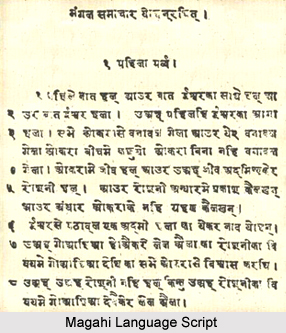 Magahi language also known as Magadhi language is spoken in India and Nepal. Magadhi Prakrit was the ancestor of Magadhi, from which the latter`s name derives. The ancestral language, Magadhi Prakrit, is believed to be the language spoken by the Buddha, and the language of the ancient kingdom of Magadha.
Magahi language also known as Magadhi language is spoken in India and Nepal. Magadhi Prakrit was the ancestor of Magadhi, from which the latter`s name derives. The ancestral language, Magadhi Prakrit, is believed to be the language spoken by the Buddha, and the language of the ancient kingdom of Magadha.
Magadhi language is closely related to Bhojpuri language and Maithili language, and these languages are sometimes referred to as a single language, Bihari language. Magadhi language has approximately 18 million speakers.
Origin of Magahi Language
Magahi language was on one occasion mistakenly thought to be a dialect of Hindi language. But it has been more recently shown to be descendant of and very similar to the Eastern Indo-Aryan languages, along with Bengali language, Assamese language, and Oriya language. It has a very rich and old tradition of folk songs and stories. It is spoken in eight districts in Bihar, three districts in Jharkhand, and has some speakers in some parts of Malda District in West Bengal. Magadhi has not been constitutionally recognized in India. Even in Bihar, Hindi language is the language used for educational and official matters.
The ancestor of Magadhi language, from which its name derives, Magadhi Prakrit, was spoken in the eastern Indian subcontinent, in a region spanning what is existed in the eastern India, Bangladesh, and Nepal. These regions were part of the ancient kingdom of Magadha, the center of which was the area of Bihar south of the Ganga River. It is believed to be the language spoken by Gautama Buddha. It was the official language of the Mauryan court, and the edicts of the greatest ruler of Maurya Empire, Ashoka were composed in it.
History of Magadhi Language
The development of the Magadhi language into its current form is unknown. However, language scholars have come to a definite conclusion that Magadhi, Maithili, Bhojpuri, Bengali, Assamese and Oriya originated from Magadhi-Prakrit language during the 8th to 11th centuries in the History of India. These different dialects differentiated themselves and took their own course of growth and development. But it is not certain when exactly it took place. It was probably such an unidentified period during which modern Indian languages begin to take modern shape.
By the end of 12th century, the development of Apabhramsa (Apabhramsa is a term that is collectively provided to the dialects that deviate from Sanskrit langauge) reached its climax. Gujarati language, Marathi language, Bengali language, Assamese language, Oriya language, Maithili language etc. tool a definite shape in their literary writings in the beginning of the 14th century.
The distinct shape of Magadhi can be seen in the Dohakosha written by Sidh-Sarahapa and Sidh-Kauhapa. Magadhi had a setback due to the transition period of Magadha management. Traditionally, strolling bards recite long epic poems in this dialect, and it was because of this that the word `Magadhi` came to mean `a bard`. Kaithi is the script generally used for it. The pronunciation in Magahi is not as broad as in Maithili and there are a number of verbal forms for each person. Historically, Magahi had no famous written literature. There are many popular songs throughout the area in which the language is spoken, and strolling bards recite various long epic poems which are known more or less over the whole of Northern India. In Magahi spoken area folk singers sing a good number of ballads.
Concentration of Magadhi Language
Magadhi Langauge is spoken in the area which formed the core of the ancient kingdom of Magadha that is the modern districts of Patna, Nalanda, Gaya, Jehanabad, Arwal District, Aurangabad District, Lakhisarai District, Sheikhpura District, and Nawada District. Magahi is bounded on the north by the various forms of Maithili spoken in Tirhut across the Ganga River. On the west it is bounded by the Bhojpuri Language. On the northeast it is bounded by Maithili and Angika language.



















